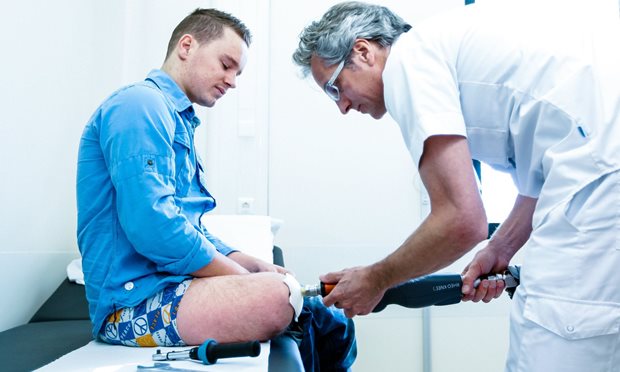

About Osseointegration
Osseointegration is used for permanent anchorage of artificial limbs to the remaining bone of a leg or arm. read moreAbout Osseointegration
Osseointegration is used for permanent anchorage of artificial limbs to the remaining bone of a leg or arm. In a two-step surgical procedure, a metal (titanium) implant is inserted into the bone of the arm or leg. Part of the implant extends beyond the skin, enabling the prosthesis to be attached with a click safety adapter.Advantages and disadvantages Osseointegration
An osseointegrated prosthesis offers many advantages to individuals with an arm or leg amputation compared with a socket prosthesis (which fits over the stump of the amputated leg or arm). read moreAdvantages and disadvantages Osseointegration
Advantages
An osseointegrated prosthesis offers many advantages to individuals with an arm or leg amputation compared with a socket prosthesis (which fits over the stump of the amputated leg or arm). The attachment of the osseointegrated prosthesis is much more stable and provides a full range of joint movement, making walking much easier. An osseointegrated prosthesis does not cause pain or skin breakdown when used. Because the prosthesis is directly attached to the bone, the wearer feels as though their prosthesis is part of their own body by a process known as “natural osseoperception” (i.e. it feels as though it is their own leg or arm). Since 2009, the Radboud University Medical Centre (Radboudumc) in Nijmegen, the Netherlands, has been offering this highly innovative technique which significantly improves the quality of life of individuals with an amputation.In 2011, the Radboudumc carried out a study of the first 22 patients to be given an osseointegrated prosthesis at their centre. Aspects of walking and quality of life with the osseointegrated prosthesis were compared with a socket prosthesis. It was found that prosthesis use increased from 56 to 101 hours per week, walking speed increased by 32% and walking required 18% less energy with the osseointegrated prosthesis. Prosthesis-related quality of life improved from 39 to 62 on a scale of 0 to 100.
Advantages of an osseointegrated prosthesis
- Increased prosthetic use
- Longer walking distances
- Full range of joint movement
- Better sitting comfort
- No skin problems
- Stable and safer standing and sitting
- A sense of the artificial limb belonging to the body
- Easy and quick attachment and removal
- Improved quality of life.
